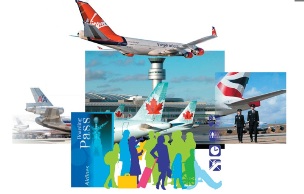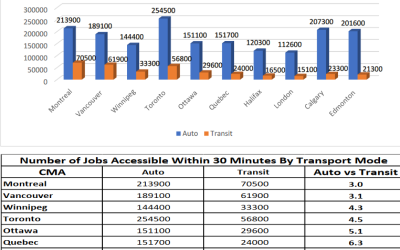Executive summary
 When it comes to airline competition and consumers, an oft-overlooked success story exists within the European Union. It is the EU policy on “open skies” or cabotage. This continent-wide policy has been an unqualified success, and it is one that Canada and the United States should emulate. In summary, this study notes the following:
When it comes to airline competition and consumers, an oft-overlooked success story exists within the European Union. It is the EU policy on “open skies” or cabotage. This continent-wide policy has been an unqualified success, and it is one that Canada and the United States should emulate. In summary, this study notes the following:
Cost comparisons of in-country flights: Europe wins
• On a per-mile basis, in a comparison of the cheapest prices of five in-country flights in Canada with five in-country flights in the United States and in Europe, Canadian air travel is significantly more expensive than either U.S. or European air travel.
Expressed another way, a traveller could:
• Book all five Canadian flights, travel a total (return) distance of 3,336 miles and pay $1,499.62, all taxes and fees included (which constitute 30 per cent of the cost).
• Book all five U.S. flights, travel a total (return) distance of 3,334 miles and pay $934.72, all taxes and fees included (which constitute 14 per cent of the cost).
• Book all five European flights, travel a total (return) distance of 3,358 miles and pay $525.72, all taxes and fees included (which constitute 52 per cent of the cost).
Taxes and fees do not explain these differences:
• European taxes and fees are higher than Canada’s or the United States’, but the fares are lower compared with the United States and Canada.
• The total average fare per mile in Canada for the five flights is 45 cents per mile; in the United States, it is 28 cents per mile; in Europe, it is just 16 cents.
• Remove the taxes and fees, and the United States and Europe still come out significantly ahead. The average base fare per mile in Canada for all five flights is 31 cents compared to 24 cents in the United States; in Europe, it is just 8 cents per mile—approximately one-quarter of the Canadian cost.
Cost comparisons of crossborder flights: Europe wins
• A similar result is found in a comparison of cross-border flights in Europe vis-à-vis North America.
• In this case, there is little difference in the total cost of five cross-border flights in North America, regardless of whether one’s flight originated in Canada or the United States.
• Flights from five Canadian cities to five U.S. destinations with a total (return) distance of 6,004 miles cost $2,034.21 if the return trips originated in Canada and $1,971.99 if those same return flights originated in the United States.
• However, five European cross-border flights (Munich-Rome, Dublin-Berlin, Vienna-Athens, Prague-Barcelona and London-Paris) would generate a total (return) distance of 6,212 miles and are significantly cheaper at $941.93.
Again, taxes and fees in Europe are the highest but fares on cross-border flights are the lowest compared to either the United States or Canada.
How European competition benefits consumers
For consumers
• Despite significantly higher taxes and fees on air travel in Europe, European consumers can find far better deals on airfare than either Canadian or American consumers can.
• The European Union’s open skies policy lowers airfare by creating a single aviation market among all member countries, and the increased competition leads to greater choice and lower fares.
• Since the market opened up, the number of cross-border routes more than doubled, and the number of routes with more than two competitors increased by 400 per cent.
For airlines and for jobs
• The single market in airline travel in Europe helped to double traffic growth, creating 1.4-million jobs.
• The European airline sector saw a six per cent growth in employment between 1997 and 2004.
• Wages for pilots increased in line with or in excess of the national average. The European Commission pointed out that increased liberalization in the European air travel market means airlines have been strengthened.
• The commission also noted that the ability to merge and invest across borders has been critical in strengthening the financial and competitive position of a number of companies such as KLM-Air France and Lufthansa-Swiss.
• As it noted in a briefing note to U.S. President Barack Obama, “cross-border flows of capital have strengthened many airlines and helped others to avoid bankruptcy, to the benefit of airlines, employees, airports and the local regions they serve.”
Full competition in North America is prevented by:
• The Canadian government, as foreign airlines still do not have full access to Canada’s internal market. The federal government made clear in 2007 that “[u]nder no circumstances will the policy approach include cabotage rights—the right of a foreign airline to carry domestic traffic between points in Canada.”
• The U.S. government, as foreign airlines still do not have full access to the U.S. internal market. This is a source of some frustration, given that U.S. carriers have gained full access to the EU internal market.
The European market contrasts sharply with the airline market in North America.
Presently, Air France can fly a passenger from Paris and drop her off in New York City or Los Angeles (or any other U.S. destination to which the airline flies), but Air France cannot pick up a New York passenger and fly him to Los Angeles. The same is true in Canada. Air France, for example, can pick up OR drop off passengers in Vancouver, Calgary, Toronto, Ottawa and Montreal, but it is not allowed to ferry passengers between those cities. Because of this restrictive and anti-competitive policy in Canada and the United States, both the airline industry (which might otherwise expand) and North American consumers suffer.
View entire study as PDF (17 Pages)
 When it comes to airline competition and consumers, an oft-overlooked success story exists within the European Union. It is the EU policy on “open skies” or cabotage. This continent-wide policy has been an unqualified success, and it is one that Canada and the United States should emulate. In summary, this study notes the following:
When it comes to airline competition and consumers, an oft-overlooked success story exists within the European Union. It is the EU policy on “open skies” or cabotage. This continent-wide policy has been an unqualified success, and it is one that Canada and the United States should emulate. In summary, this study notes the following:

